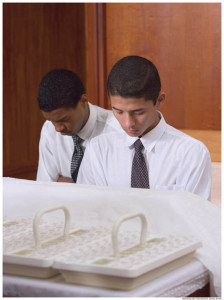When Jesus was ready to begin his ministry, he went to where his cousin John was baptizing people. He requested his own baptism. John at first hesitated, knowing Jesus had no sin and also knowing who Jesus really was. John felt Jesus should baptize him, not the other way around. Jesus insisted, though. Baptism was a commandment and even Jesus had to obey the commandments.
Later in His ministry, Jesus would tell Nicodemus:
3 Jesus answered and said unto him, Verily, verily, I say unto thee, Except a man be born again, he cannot see the kingdom of God.
4 Nicodemus saith unto him, How can a man be born when he is old? can he enter the second time into his mother’s womb, and be born?
5 Jesus answered, Verily, verily, I say unto thee, Except a man be born of water and of the Spirit, he cannot enter into the kingdom of God. (John 3:10)
And so Jesus was baptized by immersion in the Jordon River. Immersion means to go completely under the water, and in baptism it is symbolic of the death and resurrection of Jesus Christ.
Mormons baptize because it is a commandment to do so. Following Jesus’ example they are baptized by immersion. For this reason, it will come as no surprise that Mormons don’t baptize babies. However, that is not actually the reason babies aren’t baptized.
Mormons teach that the atonement of Jesus Christ overcame what some religions call original sin. They do not believe we are punished for any sins we didn’t personally commit, and commit knowingly. This means we must have reached the age of accountability, being able to learn right and wrong.
The Book of Mormon explains our feelings about why babies don’t need baptism:
10 Behold I say unto you that this thing shall ye teach—repentance and baptism unto those who are accountable and capable of committing sin; yea, teach parents that they must repent and be baptized, and humble themselves as their little children, and they shall all be saved with their little children.
11 And their little children need no repentance, neither baptism. Behold, baptism is unto repentance to the fulfilling the commandments unto the remission of sins.
12 But little children are alive in Christ, even from the foundation of the world; if not so, God is a partial God, and also a changeable God, and a respecter to persons; for how many little children have died without baptism!
13 Wherefore, if little children could not be saved without baptism, these must have gone to an endless hell.
14 Behold I say unto you, that he that supposeth that little children need baptism is in the gall of bitterness and in the bonds of iniquity; for he hath neither faith, hope, nor charity; wherefore, should he be cut off while in the thought, he must go down to hell.
15 For awful is the wickedness to suppose that God saveth one child because of baptism, and the other must perish because he hath no baptism.
16 Wo be unto them that shall pervert the ways of the Lord after this manner, for they shall perish except they repent. Behold, I speak with boldness, having authority from God; and I fear not what man can do; for perfect love casteth out all fear.
17 And I am filled with charity, which is everlasting love; wherefore, all children are alike unto me; wherefore, I love little children with a perfect love; and they are all alike and partakers of salvation.
18 For I know that God is not a partial God, neither a changeable being; but he is unchangeable from ball eternity to all eternity.
19 Little children cannot repent; wherefore, it is awful wickedness to deny the pure mercies of God unto them, for they are all alive in him because of his mercy.
20 And he that saith that little children need baptism denieth the mercies of Christ, and setteth at naught the atonement of him and the power of his redemption.
21 Wo unto such, for they are in danger of death, hell, and an endless torment. I speak it boldly; God hath commanded me. Listen unto them and give heed, or they stand against you at the judgment-seat of Christ (Moroni 8).
This scripture, then, outlines the basis for Mormon beliefs on this subject. Baptism is a part of the repentance process. An infant cannot repent and so it is impossible for him to meet the requirements of baptism. Nor can he choose for himself whether or not to be baptized. This means that God would be forever punishing a child for something he had no control over. God is not partial or random. He is our loving and fair Father in Heaven and a loving God will not punish a child He created and loves unjustly because God is just.
Before a child or adult is baptized, he is prepared for the experience. No one can walk into a Mormon Church and say, “I know nothing about you, but can I be baptized and then join your church today?” We expect potential converts to study and understand what they are signing up for and then to pray to know it is what God wants them to do. Children raised in the church are taught at home and in church classes. People nine years old or older meet with the missionaries for a series of lessons or discussions in which they are taught the basics of the religion and learn how to pray for their own testimony. In addition, of course, they attend meetings.
Prior to baptism, a person who has gained a testimony and has accepted an invitation for baptism is interviewed to be certain he is morally worthy and has prayed for his own testimony. Since baptism washes away sin, the person about to be baptized must go through the repentance process first and the person doing the interview simply makes sure it has been done and that the person is ready for baptism. The interview is confidential.
The baptism is usually held on a Saturday afternoon or Sunday after church, although it can be held on other days. The people being baptized are dressed entirely in white, usually a jump suit for modesty and easier ability to get everything under water at once. Those who come to watch the baptism (non-Mormons are welcome) gather in chairs. A hymn and opening prayer are offered. There are normally two speakers, one speaking on baptism and one on the Holy Ghost. After the talk on baptism, the person enters into the font, as does the priesthood holder doing the baptism. This can be any man age sixteen or older who holds the priesthood. Children are usually baptized by their fathers, but it is not a requirement. (After all, Jesus was baptized by his cousin, not God or Joseph.)
The priesthood holder says the baptismal prayer and lowers the person under the water. Everything must be underwater at the exact same time. Two witnesses stand on either side of the font and make sure the prayer is said correctly, since it is one of the few prayers with exact words. They also make sure the person is completely under water for a moment. If not, the baptism is redone.
Then both people go into a restroom to dry off and change clothes. While this happens, there is usually a brief movie or perhaps the sharing of testimonies. When the two who were in the font return, a talk is given on the Holy Ghost. Often a church leader and representatives of auxiliaries the person will belong to welcome them formally.
The person can be confirmed and receive the Holy Ghost that day, but it is usually done a week or two later during regular church services.
This involves a group of priesthood holders who are about eighteen or older gathering around the recently baptized person, who is seated in a chair. They place their hands on the person’s head. One person, chosen by the newly baptized person, confirms him a member of the church and commands him to receive the Gift of the Holy Ghost.
About Terrie Lynn Bittner
The late Terrie Lynn Bittner—beloved wife, mother, grandmother, and friend—was the author of two homeschooling books and numerous articles, including several that appeared in Latter-day Saint magazines. She became a member of the Church at the age of 17 and began sharing her faith online in 1992.







